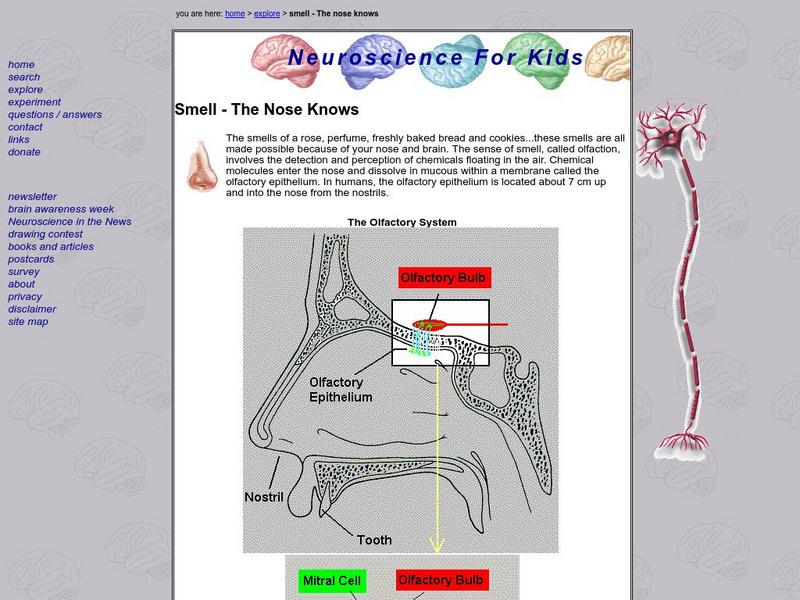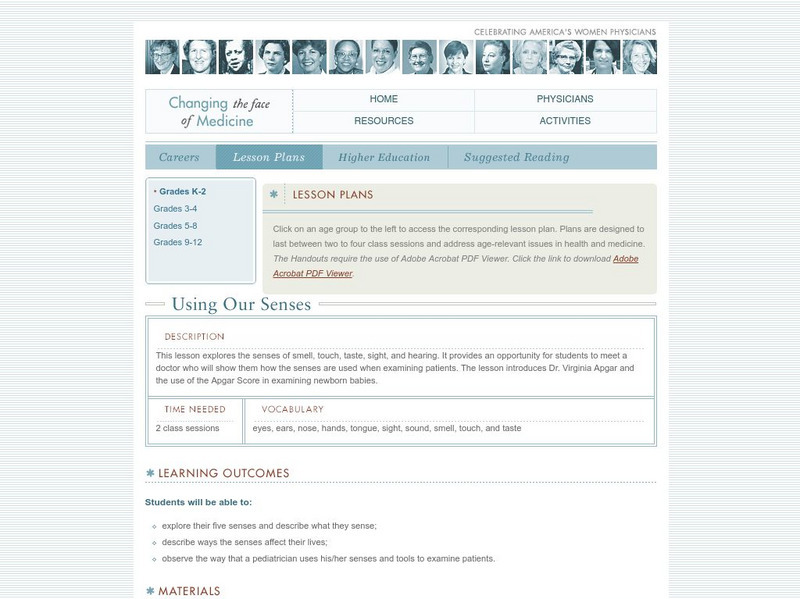Hi, what do you want to do?
Curated OER
Lesson Plan: Before and After a Moment in Time
Think about a moment, frozen in time. Now take a critical look at the painting, Better, Homes, Better Gardens. This painting works to provide learners the opportunity to analyze art, critique artist's choices, and write a story inspired...
Curated OER
Short "E" Searching
Students engage in a lesson which uses resources from the PBS show, Between the Lions to help identify the sound "e" in words that are written, read and sung.
Curated OER
Pond Water
Students explore a creek environment. They make observations, identify the living and nonliving factors in the environment and collect a plankton sample to take back to the classroom. In addition, they look at plankton under a microscope.
Curated OER
Let's Learn About Energy Sources
Second graders identify at least four energy sources through sensory experiences.
Curated OER
Using Imagery To Introduce the Endocrine System
Students listen with closed eyes to a story that starts in a relaxed tone and ends in a scream. They list the body reactions they experience: fast heart rate, shaking, etc. and hypothesize the reason for the reactions. They explore the...
Curated OER
Looking at Leaves Lesson 1
Fourth graders visit an outdoor area and compare/contrast two different leaves using Venn diagrams. They create tree leaf rubbings from their leaves and examine their vein structures or needle patterns.
Curated OER
Density and Convection Currents
Students listen as the teacher explains convection currents in the ocean. They experiment with finding a smoking match in the classroom with their eyes closed. Students discuss what might effect their ability to pinpoint the smoke...
Curated OER
Life Underground
First graders build a terrarium in order to observe animal and plant life dynamics. In this biology lesson, 1st graders compare how organisms survive in different environments. They write their observations and analysis in their journal.
Curated OER
Getting to Know My Apple
First graders compare an apple to unlike things in a simile poem. ie: The apple tastes sour like a lemon. When poems are complete, have students share their simile poems with the class and finish eating their apples.
Curated OER
Emotion Similes
Students define what a simile is before writing a poem that is based primarily on similes. They brainstorm and write the poem using the give format. They write drafts, revise and present a final poem.
Curated OER
Agreeing on Terms
Students observe and describe the wind, analyze their descriptions for clarity, and compare them both with Jonas Ramoth's descriptions and with the Beaufort Wind Scale. observations.
Curated OER
Teaching Science with a Smile
Students study science concepts as they are presented in poetic form. They write and present their own science poems to parents during Open House.
Curated OER
Writing a poem
Students imagine themselves someplace -- the beach, a mountain top, a city street -- anywhere.
Curated OER
Our Poetic Planet : Writing Poems about the Earth
Students share their thoughts regarding nature. In this poetry lesson, students compose poems in different formats that feature weather and clouds.
Curated OER
Read Aloud Lesson Plan
Students listen as the novel "On My Honor" is read to them. They identify similes and the characters differences in the novel.
Curated OER
Library Main Hall: Using Primary Sources in the Classroom
Students choose a historical photograph or film and try to predict what happened after the photo or film in question.
The Franklin Institute
In Quiry Almanack: Smelling
Site provides fun activities for kids to do in the classroom to help them better understand the sense of smell.
PBS
Newton's Apple: Taste and Smell
Discusses the senses of smell and taste and describes their interconnectedness. Provides an activity to investigate the interactive nature of taste and smell.
University of Washington
University of Washington: Nose Structure and Function
Discusses how the structures of the noseinteract to produce our sense of smell.Has links to lab activities and teacher lessonson this topic.
National Institutes of Health
National Library of Medicine: Using Our Senses
This lesson plan site delves into the senses of smell, touch, taste, sight, and hearing. Students will be able to describe the ways senses affect their lives and how a pediatrician uses his/her senses to examine patients.
The Franklin Institute
The Franklin Institute Online: Coming to Our Senses
Help students make "Sense," of their senses by using them in the classroom. Site provides discovery activities students can do on themselves, in their classrooms and around campus. A scavenger hunt is also provided.
PBS
Pbs Teachers: Mystery of the Senses Smell
Understand how the sense of smell has strong connection to the limbic region of the brain and experience how the brain associates smells with memories and emotions.
BioEd Online
Bio Ed Online: The Senses
In the following activities students can learn about the basic characteristics and structures of the brain, skull and sensory system; investigate sight, hearing, smell, taste and touch; and discover how the brain and the senses are...
Alabama Learning Exchange
Alex: Have You Seen My Mother?
This instructional activity will introduce the sense of smell. It will show how an animal, such as a bat, finds its baby by using the sense of smell. Students will have the opportunity to view information on the Internet to learn more...



























